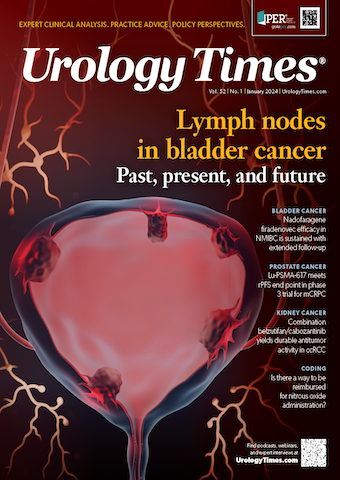News
Article
Urology Times Journal
177Lu-PSMA-617 meets rPFS end point in phase 3 trial for mCRPC
Author(s):
“No doubt about it, this is unequivocally a positive trial by the rPFS criteria. Quite positive,” says A. Oliver Sartor, MD.
Results from the phase 3 PSMAfore (NCT04689828) trial indicate that treatment with 177-Lu-PSMA [prostate-specific membrane antigen]-617 (Pluvicto) met its primary end point of radiographic progression-free survival (rPFS) and showed a favorable safety profile in patients with metastatic castration-resistant prostate cancer (mCRPC) who were taxane-naive.1
A. Oliver Sartor, MD

The data were presented at the 2023 European Society for Medical Oncology Annual Congress in Madrid, Spain, by A. Oliver Sartor, MD, a professor of medicine, urology, and radiology at Mayo Clinic in Rochester, Minnesota.
Eligibility criteria included diagnosis of mCRPC, candidacy for androgen receptor pathway inhibitor (ARPI) change following 1 progression on prior ARPI treatment, and having at least 1 PSMA-positive and no exclusionary PSMA-negative lesions by 68Ga-PSMA-11 PET/CT scan. Patients who were candidates for treatment with a PARP inhibitor, those with prior systemic radiotherapy (< 6 months prior), immunotherapy (except sipuleucel-T [Provenge]), or chemotherapy (except [neo]adjuvant > 12 months prior) were considered ineligible for the study. Patients were randomly assigned 1:1 to open-label 177Lu-PSMA-617 (7.4 GBq q6w; 6 cycles) or ARPI change (abiraterone [Zytiga]/enzalutamide [Xtandi]).
“Very, very importantly, those people on the hormonal therapies were able to crossover and to receive the lutetium if they in fact had met the rPFS end point,” Sartor said.
The study’s primary end point was rPFS, and the key secondary end point was overall survival (OS).
At the second interim OS analysis, a total of 585 patients were screened, 547 of whom received 68Ga-PSMA-11 PET/CT scans. Of these patients, 505 were PSMA-positive. A total of 234 patients each received either 177Lu-PSMA-617 or ARPI change. Fifty-one patients (21.8%) in the 177Lu-PSMA-617 arm discontinued treatment due to radiographic progression vs 146 patients (62.4%) in the ARPI change arm. Of the latter group, 123 patients (84.2%) crossed over to receive treatment with 177Lu-PSMA-617.
Baseline characteristics were similar between the 177Lu-PSMA-617 and ARPI change groups. In the 177Lu-PSMA-617 group, 119 patients (50.9%) had previously received abiraterone and 94 patients (40.2%) had previously received enzalutamide, whereas in the ARPI change group, 130 patients had previously received abiraterone (55.6%) and 84 patients (35.9%) had previously received enzalutamide.
Sartor reported that the primary end point of rPFS was met, with an HR of 0.43 (95% CI, 0.33-0.54, P < .001).
“No doubt about it, this is unequivocally a positive trial by the rPFS criteria. Quite positive,” Sartor commented.
Median rPFS was 12.02 months in the 177Lu-PSMA-617 group (95% CI, 9.30-14.42) vs 5.59 months in the ARPI change group (95% CI, 4.17-5.95).
Looking at radiographic response rates in measurable disease, objective response rate was 50.7% in the 177Lu-PSMA-617 group (95% CI, 38.6-62.8) and 14.9% in the ARPI change group (95% CI, 7.7-25.0). Specifically, there was a 21.1% complete response rate in the 177Lu-PSMA-617 group vs 2.7% in the ARPI change group. Median duration of response was 13.63 months in the 177Lu-PSMA-617 group vs 10.05 months in the ARPI change group.
Confirmed PSA decrease of at least 50% was seen in 57.6% of patients in the 177Lu-PSMA-617 group compared with 20.4% of patients in the ARPI change arm.
Findings from the prespecified crossover-adjusted analysis indicated that at a median follow-up of 12.72 months, median OS was 19.25 months (95% CI, 16.95-not evaluable [NE]) in the 177Lu-PSMA-617 group and at a median follow-up of 13.08 months, median OS was 19.55 months (95% CI, 14.95-NE) in the ARPI change group.
Regarding adverse events (AEs), 77 grade 3-4 AEs were observed (33.9%) in the 177Lu-PSMA-617 group vs 100 (43.1%) in the ARPI change group. Forty-six serious AEs (20.3%) in the 177Lu-PSMA-617 group vs 65 (28.0%) in the ARPI change group. There were 8 AEs leading to dose adjustment (3.5%) in the 177Lu-PSMA-617 group vs 35 in the ARPI change group. AEs occurring in at least 10% of patients in either arm included dry mouth, asthenia, nausea, anemia, fatigue, constipation, decreased appetite, arthralgia, COVID-19, diarrhea, back pain, vomiting, peripheral edema, and weight loss.
“In summary, PSMAfore met the primary rPFS end point with a very favorable adverse event profile, in taxane-naive patients with metastatic CRPC,” Sartor said.
Reference
1. Sartor AO, Castellano D, Herrmann K, et al. Phase III trial of [177Lu]Lu-PSMA-617 in taxane-naive patients with metastatic castration-resistant prostate cancer (PSMAfore). Presented at: ESMO Congress 2023; October 20-24, 2023; Madrid, Spain. Abstract LBA13































